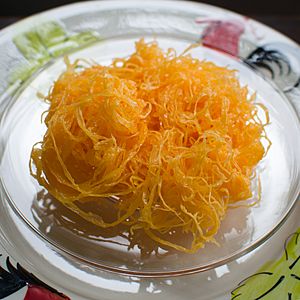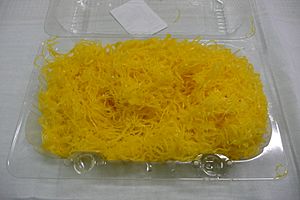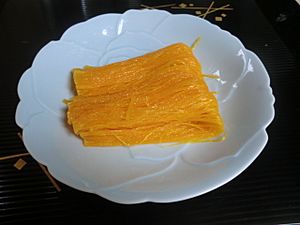Fios de ovos facts for kids

Foi thong in Thailand
|
|
| Alternative names | Angel hair |
|---|---|
| Type | Dessert |
| Place of origin | Portugal |
| Main ingredients | Eggs (chiefly yolks), sugar syrup |
Angel hair, called in Portuguese Fios de ovos ("egg threads") is a traditional Portuguese sweet food made of eggs (chiefly yolks), drawn into thin strands and boiled in sugar syrup. They are a traditional element in Portuguese and Brazilian cuisine, both in desserts and as side dishes (only in Brazil).
The preparation is also known in Spain as Huevo hilado ("spun egg"), in Japan as Keiran Somen (鶏卵素麺, "hen's egg noodle"), in Cambodia as Vawee, in Malaysia as Jala mas ("golden net"), and in Thailand as Foi Thong (ฝอยทอง; "golden strands"). In North Malabar Region of Kerala,India it is known as Muttamala (മുട്ടമാല; "egg lace").
History

Like other egg-based Portuguese sweets, fios de ovos is believed to have been created by Portuguese nuns around the 14th or 15th centuries. Laundry was a common service performed by convents and monasteries, and their use of egg whites for "starching" clothes created a large surplus of yolks. The recipe was probably taken to Japan and Thailand by Portuguese explorers between the 16th and 18th centuries.
Brazil
In Brazilian cuisine it's used to make the bolo Marta Rocha, a cake named after Miss Brazil 1954 Martha Rocha, a layered cake made with alternating layers of vanilla and chocolate sponge, topped with whipped cream, fios de ovos and sometimes other toppings like maraschino cherries and nuts. It is used in a similar way as a decoration for torta de nozes, a layer cake made with walnut sponge filled with doce de ovos (an egg custard), finished with meringue topping and fios de ovos.
Thailand
Fios de ovos is called Foi Thong in Thailand. The name of the dessert comes from the observation that it has fine, long stripes and is shiny like silk. It is considered a fine dessert. The word Thong (gold) has an auspicious connotation to Thai people. The long stripe is also seen as symbolizing a long life and undying love. Fios de ovos was introduced from Portugal to Thailand by Maria Guyomar de Pinha, sometimes considered the Queen of Thai desserts. It is served as a dessert in propitious ceremonies.
Japan
Keiran Somen is the name of Fios De Ovos in Japan. The restaurant Matsuyariemon has produced their traditional signature Keiran Somen for 13 generations, since 1673. The dessert is one of the nanbangashi, which are desserts introduced from Portugal in the Nanban trade, and the recipe has been an exhaustively guarded secret passed down from one generation to the next.
This Keiran Somen was cut into bite-sized pieces and wrapped with a line of seaweed, called Keiran Somen Tabane. The 12th generation leader of Matsuyariemon came up with the concept of the simple-to-eat dessert and beautiful form perfect for chanoyu (tea ceremony). Keiran Somen Tabane is an elegant sweet that is sure to make a good gift.
Uses
In Portugal and Brazil, fios-de-ovos are often used in fillings, decorations of cakes and other desserts and accompaniments for sweet dishes. In Brazil, they are also used as accompaniments in savory dishes, often served with canned fruits alongside Christmas turkey. In Japan, they are served in the form of dessert rolls (wagashi), and known as keiran sōmen (鶏卵素麺, egg yolk thin noodles).
See also
 In Spanish: Huevo hilado para niños
In Spanish: Huevo hilado para niños


